s
Russia is the biggest country in the world. The country has landscapes varying from snow-capped mountains to dry deserts, climates ranging from arctic to sub-tropical, and is home to a wide variety of cultures. This incredible diversity has heavily influenced Russian cuisine and made it as we know it today.
Russian cuisine has historically been very seasonal and affordable for peasants, full of fresh produce during summer and fall months and storable goods during winter and early spring.
Although old Russian foods are still popular, during the long period of geographical expansion, its cuisine began to include dishes of the peoples from Caucasus, Ural Mountains, Eastern Europe, and other neighboring regions. Today, Russian cuisine will include many dishes that are considered traditional in many neighboring countries and former parts of the Russian Empire.
So what are the 25 dishes that you might want to try if you stumble upon a Russian stolovaya (canteen) or decide to visit this vast country? Let’s find out!
1. Borscht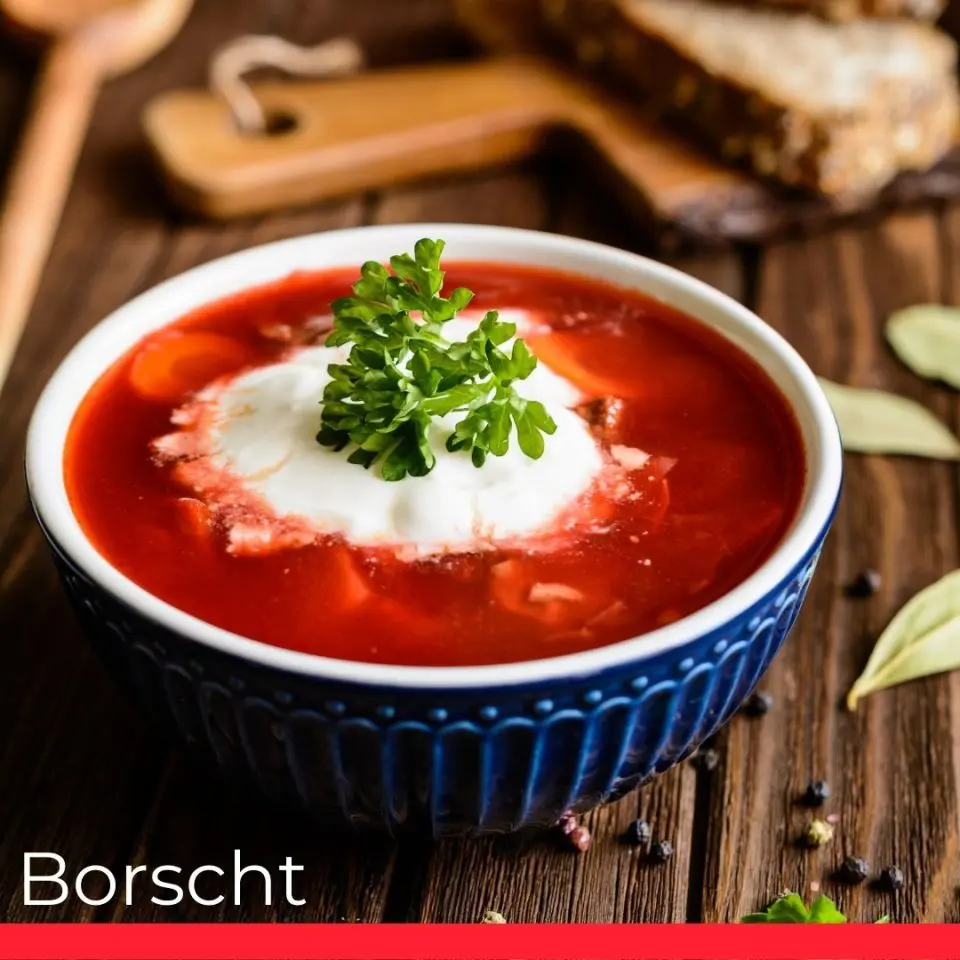
Although some might argue that this dish is Ukrainian, it has become a staple soup in Russian cuisine as well. The most important ingredient of this soup is beetroot, a vegetable that gives the dish its vibrant color. Other ingredients are usually cabbage, potato, onion, carrot, and tomato paste, to give it an even brighter color.
Most often borscht is made with beef broth, but it is just as delicious if you start off with plain water. It’s usually served with a spoonful of sour cream, some parsley or dill on the top, and a slice of bread on the side.
2. Pelmeni (Dumplings)
The history of this dish said to have begun in the Urals, where the indigenous peoples used pelmenias provision during long winter hunts in the taiga, or as part of the holiday table. Pelmeni are made of minced meat or fish, mixed with herbs and chopped onion or garlic, wrapped in thin dough, and are either fried or boiled. They are often consumed with sour cream, ketchup, or mayonnaise (or a mixture, called colloquially ketchunnaise).
Pelmeni are an extremely popular dish, and they can be conveniently stored in the freezer. Enjoy the delightful taste of the filling and juice inside the dough!
3. Bliny (Crepes)
Bliny are traditionally made with eggs, flour, and milk or kefir (a fermented milk drink), and nowadays they are mostly eaten for breakfast or on the folk holiday Maslenitsa (Butter week).
To make bliny, you need to mix the ingredients into a liquid dough and fry it as thin as possible in a pan. And guess what is served on the side. Yes, — it’s sour cream! Although some people might opt for honey or varenye (a local variety of jam made of berries or fruit). Sometimes bliny are also made with fillings, some of the most popular ones being ham and cheese or creamy mushrooms with mashed potatoes.
By the way, you can also make vegan blinys: just swap the eggs with mashed bananas and the dairy milk with a vegan one. They’re just as good!
4. Shashlik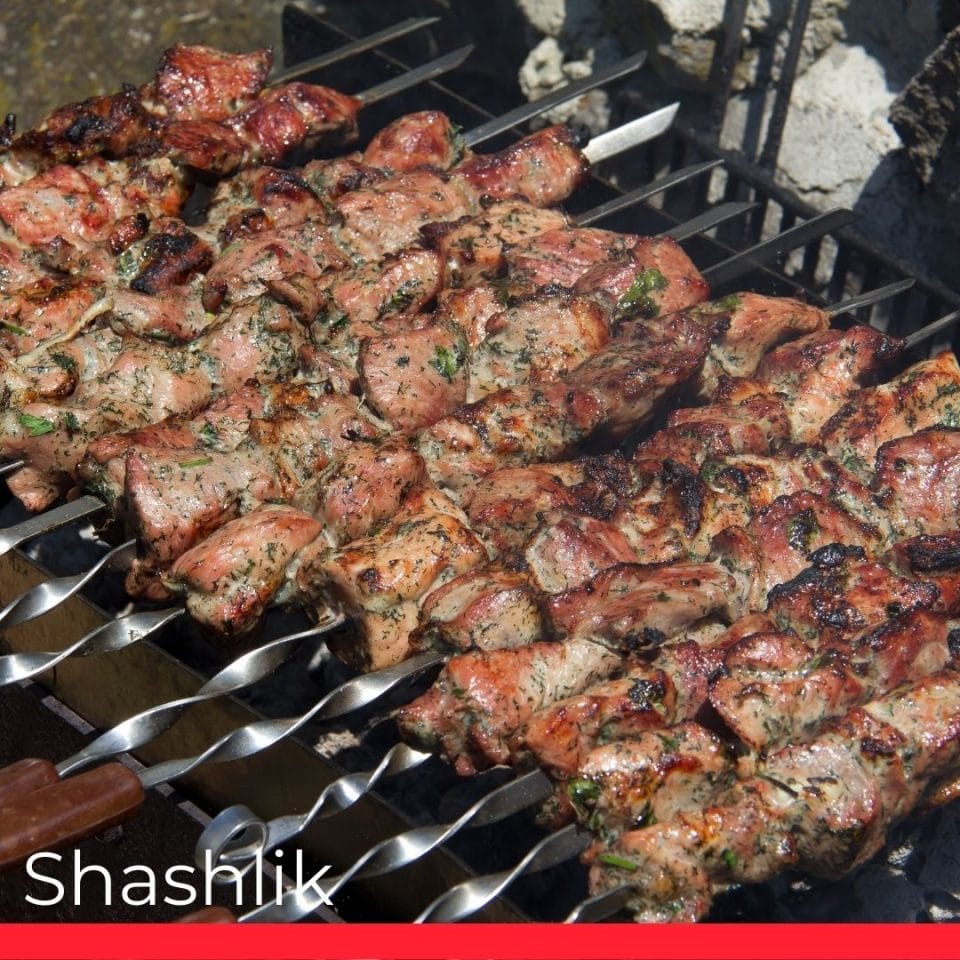
It’s a common sight in late spring or summer to see many people in parks all across the country making shashlik: pieces of marinated meat fried on a skewer over burning coals. Although shashlik originated in the Caucasus, it is now a big part of Russian culture.
Shashlik is usually made with lamb, pork or chicken cut into large pieces and marinated for a few hours. The most common marinades are kefir, soy sauce or lemon juice, mixed with herbs, spices, and sometimes vegetables such as onions, garlic, or tomatoes. To accompany it, Russians like to have potatoes, baked in foil in the coals, or grilled veggies.
Typically there is also a dip of choice, for example, ketchup or adzhika, a pungent sauce from the Caucasus. Yummy!
5. Solyanka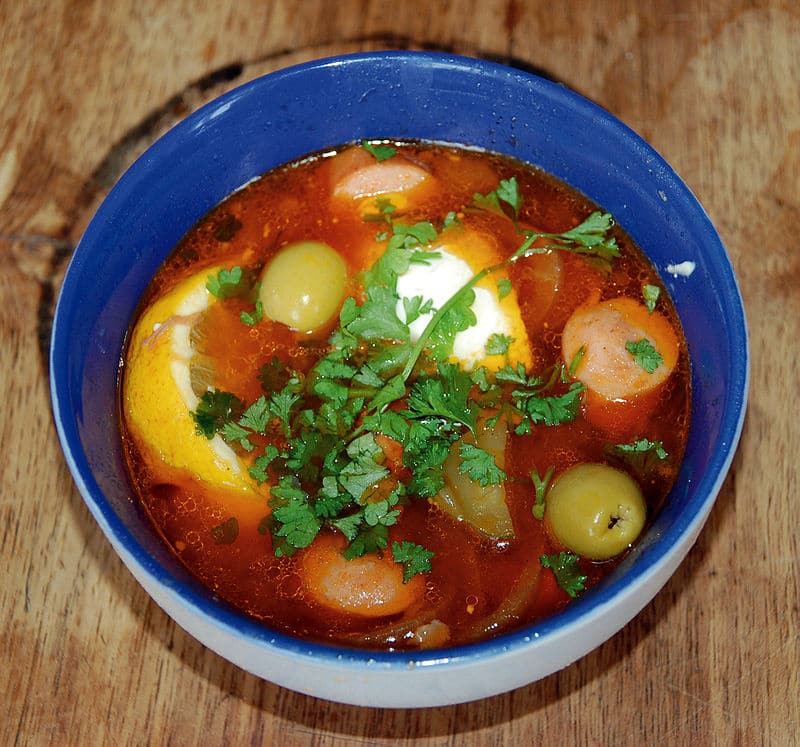 Solyanka
Solyanka
This soup is loved by many Russians because of its rich consistency and sour flavor. The name itself is derived from the word salt, and it’s one of the most distinctive qualities of this dish.
To make it, you need meat, mushroom, or fish broth. Then you need to mix chopped pickled cucumbers and brine into the broth and cook it for a little while more so that it becomes rich with the brine flavor. As with many other soups, the list of ingredients can vary depending on the particular household, but the most common are cabbage, potatoes, olives, lemon, onions, and, of course, a spoonful of sour cream!
6. Shchi
This mouth-watering soup is probably one of the most ancient Russian dishes, with its history dating back to the 9th century. It is very easy to cook, and, back in the day, people would freeze it and cut into pieces to boil as needed during extensive winter travel.Shchi is a diluted cabbage soup based on meat or fish broth. Sometimes cabbage is swapped for sauerkraut or sorrel. Other ingredients include potatoes, mushrooms, onions, carrot, and spices. Top your shchi with sour cream, slice a piece of rye bread, and enjoy this hearty and slightly sour soup!
7. Syrniki
The method for cooking syrniki is in principle the same as for bliny: make the batter and fry it. Firstly, you should mix quark (tvorog in Russian) with flour, eggs, and sugar, and maybe raisins or apricots to add more texture and taste. Then form small pancakes in the pan and make sure the insides are cooked through while staying creamy: it gives an interesting counter-taste to the well-fried sides of syrniki!Syrniki is a sweet and savoury food, usually eaten for breakfast or dessert. These are typically served with sour cream or varenye on the side.
8. Vareniki
Vareniki are often seen as a vegetarian alternative to pelmeni, and that is not too far off: wrap some dough around sweet or savory filling, fry or boil it, and there you go.
However, vareniki are not considered a variation of pelmeni in Russia, but a dish of Russian cuisine. For sweet vareniki, the most common fillings are quark or berries, a variety that is usually eaten for breakfast. Another type of vareniki can be made from potatoes with mushrooms or onions or cabbage. They are very often eaten with sour cream.
9. Kasha (Porridge)
One of the most prominent sayings about Russian cuisine roughly translates as “Shschi and kasha are our food”. And it truly is so: Russians are very fond of any kind of groats eaten for any meal of the day.
For breakfast kasha (the most common being oatmeal) is boiled with milk or water and eaten bland or with a spoonful of varenye or butter. For lunch or dinner, buckwheat is the go-to option, as it is very versatile. Try mixing boiled buckwheat with fried mushrooms and onions: the combination of the caramel-like onions, juicy mushrooms, and nutritious buckwheat is one to remember.
10. Kholodets or Studen’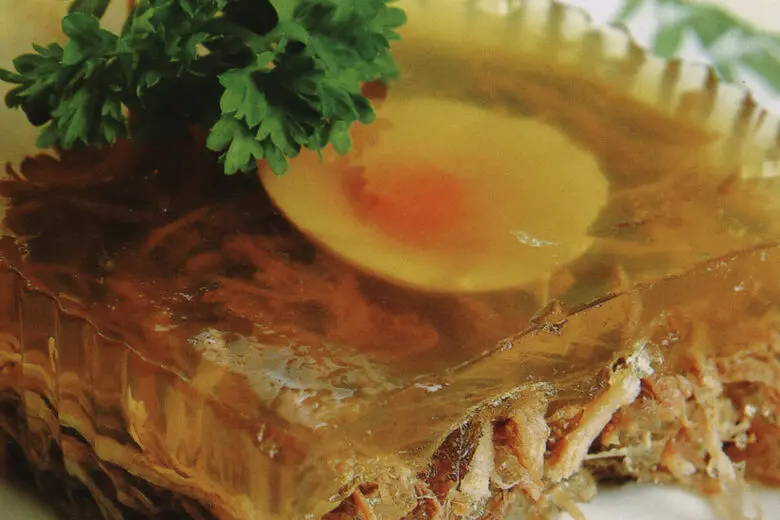
Kholodets is a food loved by many generations in Russia, even though it takes over a day to prepare! It is a jellied meat dish.
To make true kholodets, your jelly should be based on greasy pork broth, without use of gelatine. Fill the bottom of the bowl with chopped pork meat and pour the broth over it. After 24 hours in the fridge your flavorful meat jelly is ready to be served!
11. Olivier/Russian Salad
Just like the previous dish, this salad is mostly eaten on holidays, for the sake of convenience and tradition. Olivier salad is made with vegetables, meat, eggs, and generously dressed with mayo. It’s a heavy, filling, and hearty salad, most popular for New Year’s, the biggest holiday of the year in Russia.
12. Okroshka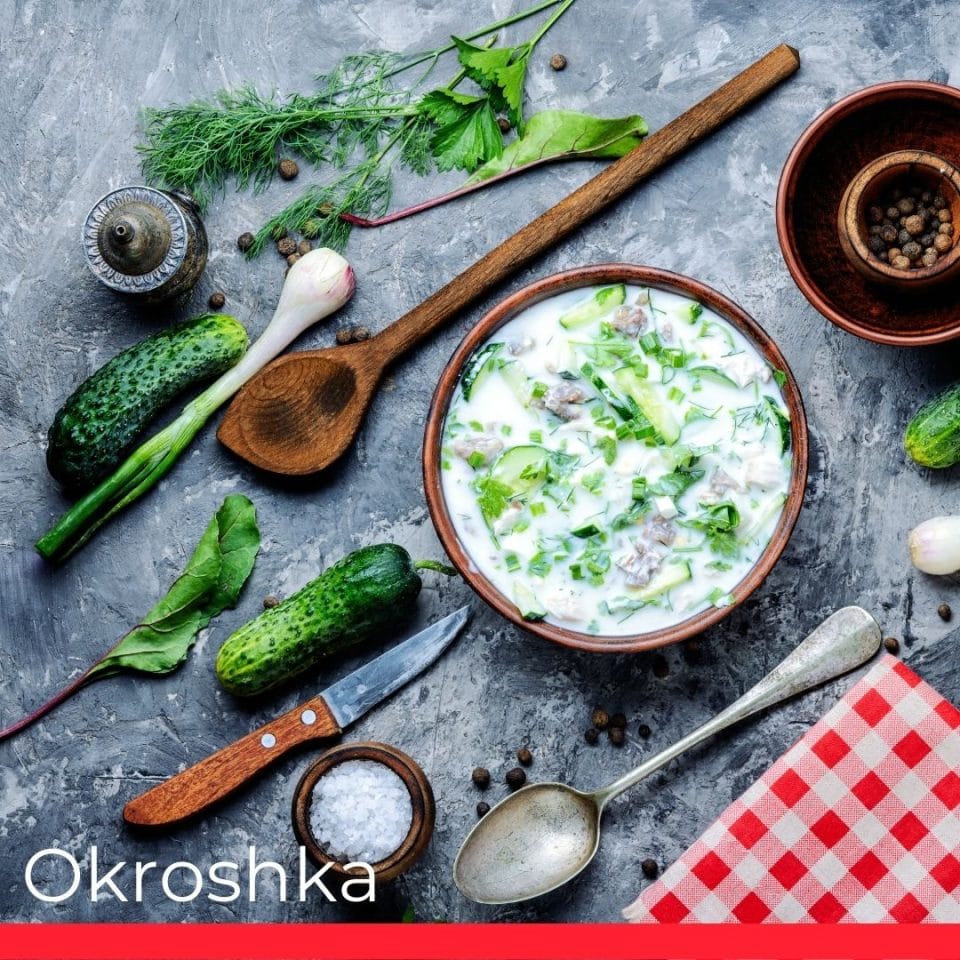
Commonly eaten in the summer, cold okroshka soup delivers a refreshing taste. Okroshka is made with raw vegetables, boiled potatoes, meat or sausages, and kvass, a fermented drink made from rye bread.
It’s important that the ingredients retain their shape and texture, so kvass is always added last. It’s a light soup, kind of like a very diluted salad, so it’s perfect for hot summers, when you don’t want heavy food.
13. Herring Under a Fur Coat / Dressed Herring
This dish with its amusing name is one of the favorite foods for the holiday table. It’s a layered salad, made of salted herring, onions, boiled potatoes, carrots and beetroots, and mayo, and decorated with grated boiled eggs. It’s a heavy dish, which requires chilling in the fridge for several hours prior to being served.
Grab a slice of this salad cake and let the harmony of tastes unfold in your mouth!
14. Kvass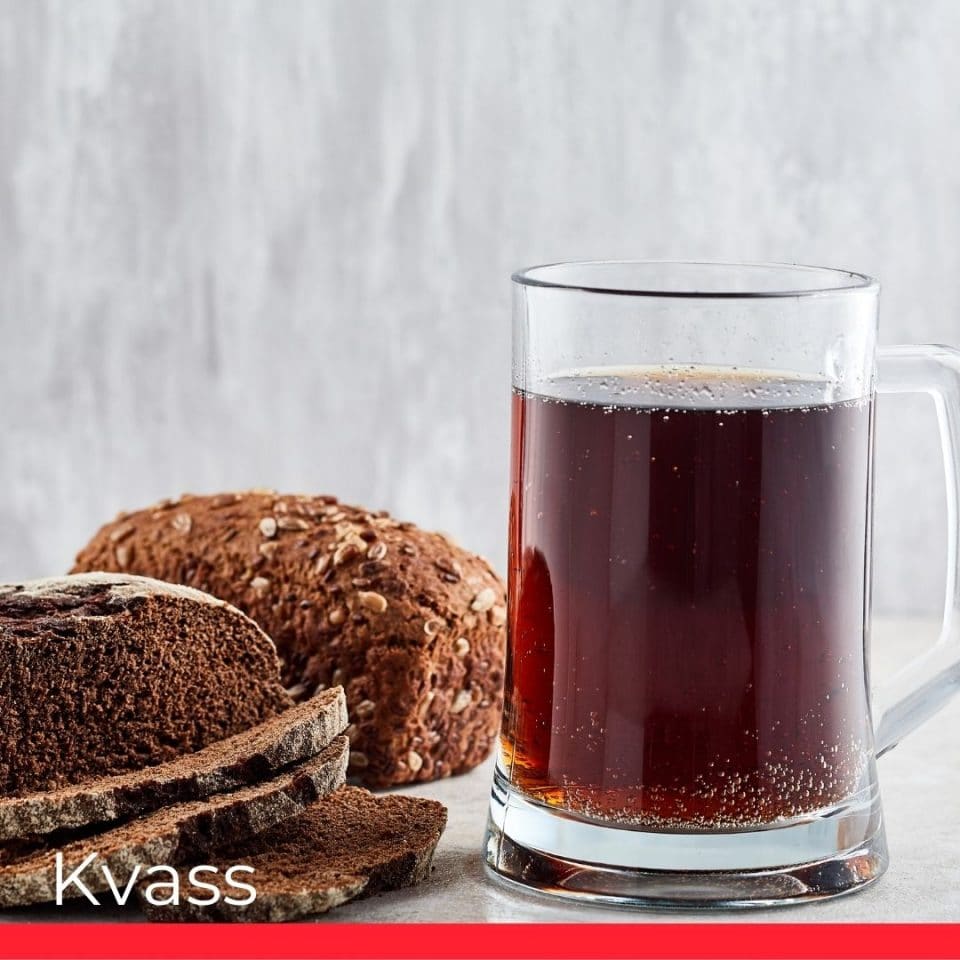
Kvass is a beloved drink of Russians of almost any age. This beverage is made by fermenting rye bread and is considered non-alcoholic by Russian standards (it is always less than 2% in alcohol).
The taste of kvass is somewhat pickley and mildly tart, and it’s most often consumed as a refreshingly cold drink on hot summer days.
15. Caviar
Fish caviar is an extremely popular delicacy in Russia, with almost any holiday table having caviar as an appetizer. The most valued caviar in Russia is obtained on the Far-Eastern peninsula of Kamchatka, where the abundance of salmon provides for packed caviar stands at local markets.
As caviar is an expensive delicacy, it is often eaten as bite-sized sandwiches made of white bread, butter, and a small spoonful of caviar.
16. Pozharsky Cutlet
Cutlets carry a tang of childhood nostalgia, and that’s why they are a favorite of almost any Russian. It could be argued that Pozharsky cutlet is the most popular. It combines tender and juicy minced meat with crispy bread crumbs, and it goes well with any sauce.
The secret to making this cutlet extra flavorful is soaking some white bread in milk or heavy cream and then adding it to the meat along with a piece of butter. This will make your cutlets extremely succulent!
17. Beef Stroganoff
Beef Stroganoff is a very famous dish outside of Russia, often served at restaurants with no connection to its home country. There are now multiple recipes for this sautéed meat dish, although most of them include two primary ingredients: beef and sour cream.
The recipe can be as simple as sautéing stripes of soft beef in butter and later adding sour cream, or more complex by adding onions, mushrooms, and other ingredients to the pan. Just make sure to take your time and let the beef get thoroughly soaked in the mixture of juices and spices. Ah, it’s mouthwatering to even think about it!
18. Pirozhki
Pirozhki are one of the go-to deserts, comfort food and street food, as they are very easy to come by in the stores and to prepare. Just choose the filling and place it into rolled out dough.
Pirozhki are usually baked, but in the Eastern part of Russia they are more often fried. Take some pirozhki with you on a hike, you will appreciate the boost of energy and the tasty experience!
19. Ukha
Soups are considered a very healthy meal in Russia, and that’s why there are so many of them, many more than mentioned here. Ukha is a traditional fish soup, consisting, in addition to the obvious primary ingredient, spices, potatoes, carrots, onions, and, less commonly, other veggies. It’s very nutritious, rich, and savory.
20. Rassolnik
Rassolnik is one of the many salty soups or foods on this list, with word rassol (brine) being so key that it even made its way to the soup’s name.
A proper rassolnik is made with pickled cucumbers, brine, meat, and pearl barley. It’s very comforting, slightly sour, and very hearty. Add some sour cream to make it heavier, if you like—that will make it all the more traditionally Russian.
21. Fermented Dairy Products
Russians got very creative with their dairy both due to the living conditions and the influence of Turkish cuisine and other cultures.
There are so many fermented dairy foods that can be found in Russian grocery stores, the most notable and wide-spread being sour cream (or smetana — I had to dedicate a special mention to smetana on this list!), kefir (sour and astringent milk drink made from kefir grains), and tvorog, known also as quark.
These foods are consumed daily, kefir and tvorog being some of the most important parts of a healthy diet in Russia. And smetana simply holds a special place in every Russian’s heart, as it is such a vital addition to most dishes.
22. Vinegret
Vinegret is often served as a light and nutritious salad or appetizer. This salad, as it is now prepared in Russia, has strayed quite far off of its original Western European recipe.
It’s a vegetarian-friendly salad made from beets, potatoes, carrots, onion, pickled cucumbers (or, more rarely, sauerkraut), and dressed with vegetable oil. It’s sour—due to the brined pickles—and salty, and also very light and filling at the same time.
23. Pryaniki
Pryaniki is one of the staple sweets of Russian cuisine and has been around for a very long time. It’s consistency is very similar to that of gingerbread, but the recipe involves no ginger. It is honey that is essential for a traditional pryanik recipe.
Tula pryanik is probably the most culturally-significant type of pryaniki, so much so that it is nowadays considered an art creating proper pryanik decor in Tula city. Pryaniki are often eaten with a glass of tea. And did you know that Russia often ranks in the top 5 tea consumers of the world?!
24. Pickled Goods
Oh how Russians enjoy eating pickled foods! It is not uncommon to find Russians in a cafe enjoying a plate of different pickles as an appetizer.
Some of the most popular original ingredients for pickling include cucumbers, garlic, tomatoes, wild garlic, and cabbage (as sauerkraut). Also brine, or rassol, is an extremely popular hangover solution, as its rich in salts, helping to restore the proper mineral balance in the body after a good night out.
25. Sbiten’
Sbiten’ is a very traditional drink in Russia, possibly one of the most ancient with its roots deep in Russian culture. It can be sweet, spicy, or both, all depending on the recipe. Honey is the key ingredient for this heart- and body-warming winter drink, which is boiled with spices and jam. It’s popularity has significantly decreased with the increase in tea consumption, but it’s being rekindled now in the 21st century.
Source: https://www.chefspencil.com/





